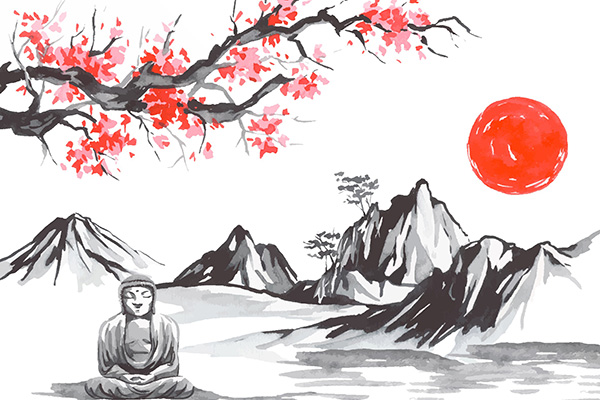The Meditative Art Of Sumi-e Painting
 As a spiritual advisor and artist, I’ve always been drawn to the ways in which art and spirituality intersect to offer pathways to deeper self-awareness and tranquility.
As a spiritual advisor and artist, I’ve always been drawn to the ways in which art and spirituality intersect to offer pathways to deeper self-awareness and tranquility.
One such path that has had a profound impact on my life is Sumi-e painting, also known as suibokuga or ‘ink wash painting.’ It is a traditional Japanese painting technique that uses black ink, typically in varying concentrations, to create brushstroke-based works of art.
Sumi-e is characterized by its minimalism, simplicity, and emphasis on capturing the essence or spirit of the subject rather than its literal representation.
Paintings often feature subjects such as landscapes, flowers, birds and other natural elements. Artists use various brush techniques to create different textures, tones, and depths using only black ink on absorbent paper or silk.
The art form has deep roots in Zen Buddhism, which emphasizes spontaneity, simplicity, and harmony with nature. Practitioners often meditate before painting to cultivate a clear and focused mind, which they believe enhances their ability to express the essence of the subject.
Sumi-e painting has had a significant influence on various art forms, including calligraphy and other East Asian brush painting styles. It continues to be practiced and appreciated for its timeless elegance and ability to evoke profound emotions with seemingly simple brush strokes.
The focus or purpose of Sumi-e/Zen painting is not the outcome but the process of creating while in the state of heightened intuition and of sensory awareness ~ Lilith Ohan
The Ancient Origins Of Sumi-e
The origins of Sumi-e painting can be traced back to China, where it initially emerged as a part of Chinese brush painting during the Tang Dynasty (618-907 AD). However, it was during the Song Dynasty (960-1279 AD) that the art form began to take on characteristics that would later define Sumi-e.
Japanese monks studying in China during the Song Dynasty brought back with them the practice of ink painting, which they then adapted and refined in Japan. Over time, Sumi-e evolved into a distinct art form with its own techniques, aesthetics, and philosophical underpinnings.
One significant figure in the development of Sumi-e in Japan was the Zen Buddhist monk, painter, and poet, Sesshū Tōyō (1420–1506). Sesshū played a pivotal role in popularizing ink painting techniques and incorporating Zen philosophy into artistic practice. His work emphasized spontaneity, simplicity, and the expression of the essence of the subject rather than its literal representation.
Sumi-e flourished during the Muromachi period (1336-1573) in Japan, particularly among Zen Buddhist monks and literati scholars. It became closely associated with Zen Buddhism, as practitioners used painting as a means of meditation and self-expression. This spiritual connection remains integral to Sumi-e practice today.
Throughout its history, Sumi-e has been influenced by various cultural and artistic movements, but it has retained its essential qualities of simplicity, harmony, and a deep reverence for nature. Today, Sumi-e continues to be practiced and appreciated not only in Japan but also around the world for its unique blend of artistic expression and spiritual contemplation.
Sumi-e As A Spiritual Ritual
My first encounter with Sumi-e painting came at a time when I was searching for a form of expression that could also serve as a spiritual practice. Sumi-e captivated me with its minimalist beauty and its deep philosophical roots in Zen Buddhism.
The art form is not just about painting an object or scene; it’s about capturing the spirit or essence of the subject using only black ink, a brush, and rice paper.
I began my journey into Sumi-e with a few simple tools and an open heart. I quickly learned that this art form requires a unique blend of concentration and relaxation – each stroke of the brush must be executed with full presence and mindfulness. In essence, it is a form of mindful meditation, as the focus is on being fully engaged in the moment.
The more I practiced Sumi-e, the more I found that it was much more than an artistic endeavor; it was a spiritual ritual. Each time I dip my brush into the ink and touch it to the paper, I am engaging in a practice of letting go.
Sumi-e requires an acceptance of imperfection and asymmetry, reflecting the inherent beauty of the natural world. This resonates deeply with me as it mirrors the unpredictable ebb and flow of life.
Symbolism in Sumi-e goes beyond technique, encapsulating profound symbolism often inspired by nature. Each brushstroke aims to convey the spiritual and emotional essence of the subject, prioritizing essence over realism ~ Mitsuru Nagata
The Four Gentlemen Of Sumi-e
One of the fascinating aspects of Sumi-e painting is the study and mastery of the Four Gentlemen, also known as the Four Noble Ones or Four Friends. They are the four plants – bamboo, orchid, chrysanthemum, and plum blossom – that serve as the basic subjects for learning the brushwork and philosophy of Sumi-e and are commonly depicted in Sumi-e painting.
These four plants are not only celebrated for their natural beauty, but also revered for the virtues they embody. In Sumi-e painting, artists often use these subjects to explore themes of resilience, beauty, and the passage of time, capturing the essence of each plant with simple yet expressive brushstrokes. Each plant represents a different season and embodies certain virtues or qualities valued in both Chinese and Japanese cultures.
Bamboo (竹, Zhú): Representing summer, bamboo symbolizes resilience, flexibility, integrity, and strength. It is often depicted with tall, straight stalks and delicate leaves, reflecting the plant’s ability to bend without breaking in the face of adversity.represents the resilience and integrity of a strong yet flexible character.
Orchid (蘭, Lán): Symbolizing spring, the orchid represents purity, elegance, and refinement. Its delicate blossoms and slender stems are often depicted with great attention to detail, capturing the ethereal beauty and grace of the flower. Painting orchids teaches the artist about the subtle flow of energy and the delicate balance of life.
Plum Blossom (梅, Méi): Representing winter, the plum blossom symbolizes endurance, perseverance, renewal, and hope. Blooming in the midst of winter’s cold, the plum blossom is admired for its delicate, fragrant flowers and its ability to thrive in harsh conditions. It teaches us that we have the power within to thrive despite setlbacks and challenges in our life.
Chrysanthemum (菊, Jú): Symbolizing autumn, the chrysanthemum represents longevity, rejuvenation, perseverance, and inner strength. Known for its vibrant colors and intricate petals, the chrysanthemum often depicted in various stages of bloom, from buds to fully open flowers, reflecting the cycle of life and the passage of time. Depicted in full bloom it represents abundance, prosperity, and vitality.
Each of these subjects is not just a plant to be reproduced on paper, but a lesson in life’s virtues taught through the simple yet profound medium of ink and brush.
Sumi-e has become a cherished part of my daily routine, a sacred time when I can connect with myself and express my innermost feelings without words. If you’re looking for a new meditative practice, or simply want to try a different form of artistic expression, I wholeheartedly recommend exploring the serene world of Sumi-e painting. It’s not just about creating art; it’s about creating moments of peace in our often chaotic lives.
What I love most about Sumi-e is its accessibility. While the technique can take years to truly master, anyone can pick up a brush and begin to explore this art form. It also does not require expensive materials or a large studio. A quiet corner, a few simple tools, and a willing mind are all that’s needed.
I encourage you, artist or not, to try Sumi-e painting. Think of it as a form of moving meditation, a way to quiet your mind and explore your inner landscape. It’s a practice that can lead to profound peace and personal insight, as it has for me.
|
|

Leave a Reply